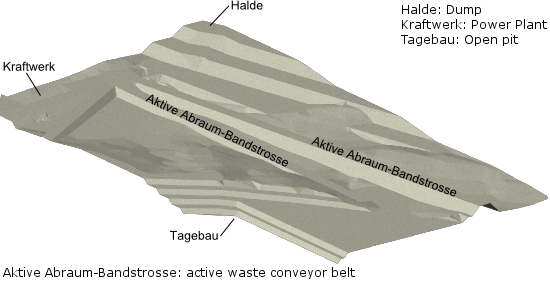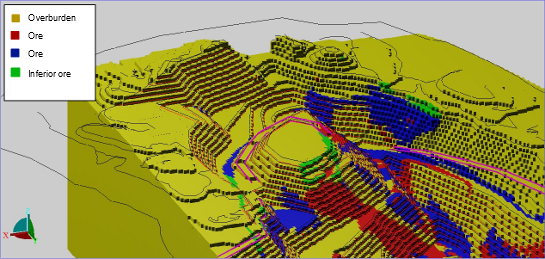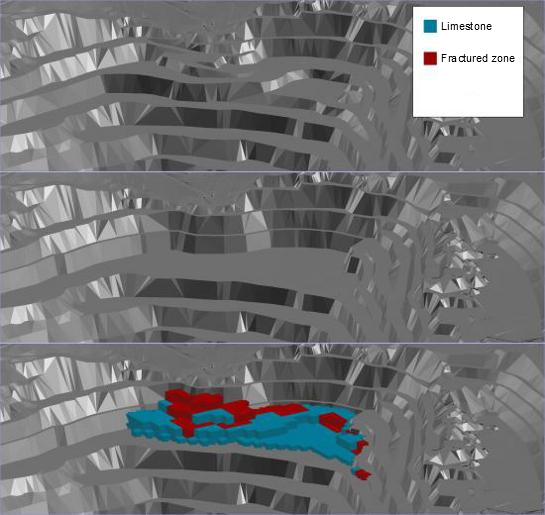Mine Planning
BANPU Mine Masterplan Open-Pit Hongsa
This project covered the 30 year planning of a lignite open pit in Hongsa (Laos). Following the preliminary measures, such as geographic referencing and digitalisation of the topography, FUMINCO integrated the existing mining stages into the topography.
The following mine site planning, conducted by FUMINCO, started with the exposure of an additional, separate pit in the area of the future mine dump. After exploiting the resources of this deposit, the planning of the mine dump began.
This planning involved the layout of two spreader-conveyor belt-systems. These two conveyor belt-systems and a coal-conveyor belt-system were integrated into the pit. The clients mining stages were adapted to the new developments.
In addition, the infrastructure for water supply and drainage (trenches, pipes and pumps) as well as for traffic (road) were planned in tight cooperation with the client. The planning was concluded by the creation of a recultivation plan for the “FINAL LAYOUT YEAR 2038”, which includes agricultural and silvicultural usable areas as well as flooding areas integrated into the pit and facilities for water containment in the dumps.

The final working step for the project was the documentation for the client. 33 DIN A0 blueprints were created, consisting of four blueprints for the corresponding exposure years (2009 to 2012), half-year mining stages for 2009 to 2012, twelve stages for 2013 (start of core production), four quarter-year stages for 2014, four year stages (2015 to 2018) and finally five five-year stages (2023, 2028, 2033, 2038, recultivation plan).
Mauritania (MAN Ferrostaal AG/SST GmbH)
This project involved a 25-year exploitation planning of an iron ore open pit in Mauritania. Our clients were tasked with this comprehensive mine planning in the context of a feasibility study by the state-owned mining company Société National Industsrielle et Minière (SNIM).
The geological block model of the deposit, that was provided, contained three kinds of iron ore and mining waste. Amongst the two major kinds of ore this deposit held a type of poor-ore. This meant that not only the ore-waste-ratio but also the ratio of the three types of ore had to be regarded. These framing parameters were dictated by the downstream mineral processing facilities in this arid area.

During the mine planning, mining stages for the first five years were created initially, followed by four five-year stages. The mining was planned with the application of the “Shovel and Truck” system with multiple exploitation sites in the pit. The planning of the dump was performed by the clients mining engineers, with whom the dump and the mine planning was finally merged in close cooperation.
After the clients approval of the mine planning, the first step was to calculate level wise the volume and mass for each type of ore and for the mining waste. This was done for each of the exploration sites. A second step included the determination of the corresponding conveyance paths for the centers of mass. Based on this determination the corresponding transport capacities were calculated for each year. Finally, the application of an IPCC-system (crusher-conveyor belt-spreader) was examined.
Wülfrath (Rheinkalk GmbH/SST GmbH)
In the open pit Rodenhaus in Wülfrath (Germany), limestone is mined, which is, for example, required for the production of steel. The quarry is operated by the Rheinkalk GmbH, which belongs to the Lhoist Group.
For the pit Rodenhaus, a 25-year mining plan was created. This plan was made concrete in a second step in the context of a 5-year mining plan. Within this project FUMINCO took care of the complete mine site planning, from the determination of the future direction of the mine site to the detailed planning of the mining in multiple mine sites. In addition, we performed a controlling of the planning results, supported by a self-written database application.
The complex geological situation of the pit and a difficult situation concerning the waste disposal in the forefield of the quarry required a distribution of the cumulative production to nine focuses of mining in total, as well as a weekly analysis of the limestone exploitation. At the same time, the movement of the waste was planned. In the pits of the Rheinkalk GmbH excavators, wheel dozers and dumpers are deployed and the mining process requires explosives. Only the overburden can be loaded onto the dumpers directly.

In the context of the mine planning the existing wells for the drainage of the quarry had to be taken into account to be able to keep the drainage of the quarry in operation as long as possible. In addition, new sites for drainage wells hat to be determined. The sites of the drainage wells had to be planned in order to operate until the end of the life of mine.
Furthermore a planning for the exposure of a second quarry (Silberberg) was performed, which included the integration of the production of the new pit into the comprehensive operational concept. The geological modelling and the controlling were performed by the client and in close cooperation with the management of the Prof. Stoll und Partner Ingenieurgesellschaft mbH (SST Gmbh).


